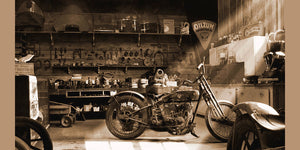Explore the Latest Motocross Gear NZ for Every Level of Rider
Wiki Article
Recognizing the Crucial Components of a Motorbike: A Comprehensive Guide for Enthusiasts
For motorbike enthusiasts aiming to raise their riding experience and guarantee their bikes run efficiently, comprehending the essential components of a motorbike is vital. Each element, from the engine's detailed workings to the critical role of the braking systems, not just affects performance but likewise safety and security and convenience. This guide will stroll via the fundamental parts that every cyclist ought to know with, making it possible for informed choices in both maintenance and possible upgrades. As we start this exploration, one must ask: exactly how does each part interact to produce the smooth trip every lover seeks?Engine Elements

The camshaft plays a critical duty in regulating the timing of the engine's shutoffs, guaranteeing the specific opening and closing needed for effective fuel and air intake, as well as exhaust expulsion. This timing is crucial to maintaining optimum engine efficiency and performance. In addition, the carburetor or fuel injection system, relying on the motorcycle model, is in charge of blending air with gas in the proper ratio for burning.
The cooling system, either air or liquid-based, functions to keep the engine's temperature within functional limitations, stopping getting too hot and ensuring longevity - motocross gear. Each part, carefully created and incorporated, adds to the seamless operation of the engine, defining the motorcycle's power outcome and overall efficiency
Transmission System
Integral to the motorcycle's performance, the transmission system makes sure reliable power transfer from the engine to the wheels. This system consists of numerous crucial elements, consisting of the clutch, transmission, and last drive, each playing an essential duty in translating the engine's power into movement. The clutch, usually run by a hand bar, offers to involve and disengage the engine from the transmission, permitting smooth gear changes and controlled acceleration.The gearbox, often referred to as the transmission proper, contains a set of gears that riders can by hand change with to change the bike's speed and torque outcome. These gears are organized in a series that allows the motorbike to increase efficiently and preserve ideal engine performance across different rates. A lot of bikes make use of a consecutive transmission, needing the cyclist to change gears in an established order.
Braking Systems
While comprehending the transmission system is essential to utilizing a bike's power, similarly essential is the ability to regulate and stop that power successfully, which is where stopping mechanisms come into play. Brakes are essential for safety and efficiency, offering the rider with the needed control to navigate different terrains and problems. Commonly, motorbikes feature 2 types of stopping systems: disc brakes and drum brakes.Disc brakes are extra common in modern-day bikes due to their exceptional efficiency. This system offers much better warmth dissipation, consistent performance, and improved quiting power, especially in wet problems.
Conversely, drum brakes, though much less usual, are still discovered in some motorcycles. They work by pushing brake shoes versus the internal surface area of a drum attached to the wheel. While normally much less reliable in warmth dissipation and quiting power, drum brakes are simpler and much more cost-efficient.
Comprehending these stopping systems' subtleties permits cyclists to maintain their motorcycles correctly and appreciate the design that makes sure secure and efficient stopping.
Suspension and Steering
Suspension and steering check my source systems are essential components that dramatically affect a bike's handling and ride comfort. The shock absorber, being composed of forks at the front and shock absorbers at the back, soaks up roadway abnormalities, boosting security and control. Front forks, generally telescopic or inverted, compress and rebound to reduce impacts, while rear shock absorbers keep tire call with the roadway, crucial for traction and safety.Steering, focused around the handlebars, weblink attaches the rider to the motorbike's directional control. The guiding head bearings guarantee smooth operation, permitting precise maneuverability. Proper positioning and upkeep of these bearings are crucial for predictable guiding feedback and decreasing rider fatigue.
The suspension's adjustability is another crucial aspect; preload, damping, and rebound setups enable personalization to suit numerous riding styles and problems. This versatility is vital for enhancing performance, whether browsing urban roads or tackling sturdy tracks. Innovations like digital suspension systems use real-time modifications, boosting experience quality throughout diverse surfaces.

Electrical Solutions
After making certain a smooth and controlled ride through effective suspension and guiding systems, interest transforms to the electrical systems, a crucial aspect of modern bikes. These systems play a crucial role not just in starting the engine yet likewise in powering numerous components that boost the capability and safety of the motorbike.At the heart of a bike's electrical system is the battery, which shops electric power required for beginning the engine and powering complementary systems - mx gear nz. The generator or generator, coupled with the rectifier-regulator, makes sure the battery remains billed while the motorbike is in operation, converting mechanical power into electric power and maintaining voltage levels
The ignition system, another important part, is responsible for sparking the air-fuel blend in the engine's cyndrical tubes. Modern bikes often utilize an electronic ignition system, offering greater effectiveness and integrity contrasted to typical systems.
Lighting systems, consisting of fronts lights, tail lights, and indications, are additionally essential, guaranteeing exposure and security for the biker. Extra electronic components such as sensors, control units, and displays add to sophisticated functions like gas shot monitoring, anti-lock stopping systems (ABDOMINAL), and electronic control panels, further boosting the riding experience.
Verdict
A comprehensive comprehension of a motorbike's vital elements, consisting of the engine, transmission system, stopping systems, suspension, steering, and electrical systems, is essential for lovers intending to optimize comfort, safety and security, and efficiency. Mastery of these aspects permits notified choices concerning upkeep and upgrades, go to website ultimately improving the riding experience. By incorporating this knowledge, motorcyclists can guarantee their motorcycles run at peak performance and dependability, therefore making best use of both pleasure and durability of their lorries.For motorcycle lovers looking to raise their riding experience and guarantee their bikes run smoothly, understanding the necessary components of a motorcycle is vital.Indispensable to the motorbike's capability, the transmission system ensures efficient power transfer from the engine to the wheels.While comprehending the transmission system is key to taking advantage of a motorcycle's power, equally vital is the ability to regulate and stop that power successfully, which is where stopping systems come into play. Generally, motorbikes feature two kinds of braking systems: disc brakes and drum brakes.
A detailed understanding of a motorcycle's vital elements, consisting of the engine, transmission system, stopping devices, suspension, guiding, and electric systems, is crucial for fanatics intending to maximize efficiency, convenience, and safety.
Report this wiki page